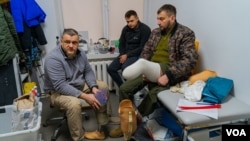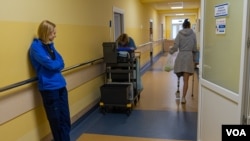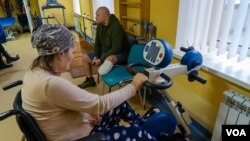There is a certain bravura among war-wounded amputees at the St. Panteleimon Hospital in Lviv, Ukraine.
We meet two men on their lunch break from demining roads and neighborhoods. Both are missing the lower half of one leg from mine explosions on the job, and six of their teammates have also recently lost limbs.
“We are too busy to be psychologically damaged from this,” says Taras, 40, a soldier and father of two.
“This guy works and has four kids,” he adds, gesturing to his colleague who wraps and re-wraps his stump before trying on a slightly smaller temporary prosthetic. A few minutes later the pair head back out to search for more of the mines that litter large swaths of Ukraine.
The prosthetist, Nazar Bahniuk, explains their quick visit to the hospital, saying man-made limbs need to be replaced or adjusted from time to time, because a person’s thigh is not accustomed to carrying their weight.
“You stand on your heels and feet since you are maybe one year old,” he explains.
Most of Bahniuk’s patients come from battle zones in eastern Ukraine, the heart of the nearly yearlong war with Russia, but there is no region of the country that has been completely spared, he says. About 75% are soldiers and the rest are civilians, including a 70-year-old woman who recently stepped on a landmine.
The waiting list for prosthetics at his hospital is in the hundreds, adds Bahniuk.
Upstairs in a rehabilitation room, patients use treadmills and a stationary bike to gather their strength. Andriy, 44, lost his leg in September on a mission in Kherson, a city that was occupied by Russia for nine months before being freed by Ukraine and is now under constant attack.
We asked how he feels about losing his left leg.
“I’m sad I lost my time,” Andriy replies. “I’ve been in the hospital for months when I could have been fighting in the war.”
Children prepare
In the Lviv city center, where markets are packed by day with a population long swelled by displaced families, the local tourism office now serves as a press center. They offer emergency first aid kits, body armor and helmets to freelance journalists.
Olga Letnianchyk, a press center official, is also the mother of an eight-year-old girl. The school is open, she says, and children regularly go down into the basement when the air raid sirens go off or bombs hit the region, usually aiming at infrastructure outside of the city. Her daughter has a bag prepared in case of long stays in the shelter, she says, which holds water, a snack and a teddy bear.
But Lviv is comparatively safe, and more than a thousand kilometers from the ground war, Letnianchyk adds, which is why she stayed home when millions of other people fled Ukraine.
“It would be harder,” she adds, “to be outside and not be able to do anything.”
Like many people here, she jokes about the dangers of the war, saying after almost a year, the new ways of life in Ukraine have become ‘almost’ normal.
But only almost, she emphasizes, saying one never really gets used to bombs sailing in from the sky from more than a thousand kilometers away.
“It is mostly OK,” she says. “But don’t look up.”











